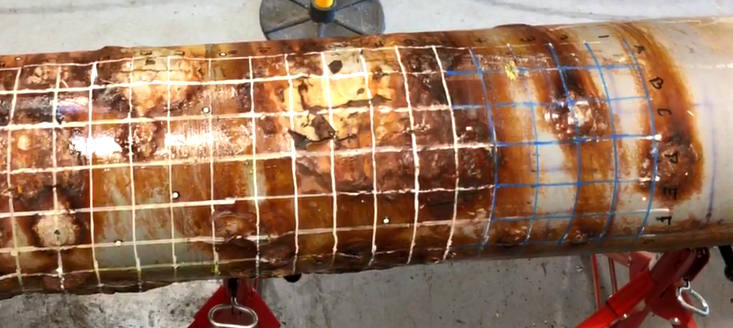
The NDT industry has long required an inspection technique that accurately determines the condition of pipe surfaces below formed scabs. The latest Pulsed Eddy Current (PEC) technology provides just such a solution – and can be applied while pipes are still in service.
Objective
The objective of this qualification is to establish the capabilities of the system specific to quantifying the remaining wall thickness below surface forming scabs.
Any robust system must be capable of quantifying the remaining wall thickness below surface-forming scabs. Enter the Eddyfi LYFT high-performance pulsed eddy current solution.
What is LYFT?
This latest system has state-of-the art technical features and offers real-time C-scan imaging. Data acquisition is rapid with up to 15 readings per second. The system’s functionality includes both grid-mapping and dynamic scanning modes. It is also portable and user-friendly with cables that extend up to 65ft.
Inspection Sample
The sample selected for inspection is a spool containing large areas of surface scabs as per the main image.
The area to be inspected was “gridded A to I” on the circumferential axis and “1 to 28” along the longitudinal axis.
Next Steps:
- The material thickness was measured using ultrasonic techniques (UT) in the areas where the surface condition has not been effected with surface oxidisation and a table created as per table one.
- Readings were also taken with the PEC system a table of readings was created, table two. Reading could be taken within every location.
- A third table was then created subtracting the UT readings from the LYFT readings, namely table three.
The results of table three show where both a UT and LYFT reading were taken, the readings have a variation of on average 0.4mm with the highest reading giving a variation of 0.9mm. The areas are identified as yellow in the table 3.
The blue areas in table 3 are where no UT data was taken (so where a scab is present on the surface).
As the variation between UT and LYFT readings are consistent on the nominal wall thickness areas, then some confidence in the accuracy of the readings below the scabs can be taken.
Conclusion
The qualification was conducted in a timely manner from start to completion. It identified the LYFT successfully measured thicknesses in the same region where nominal wall thickness was present, (no surface scabs present).
This provides a degree of confidence in the readings taken from the other areas of the sample. Limitations of the PEC system always need to be considered with the results provided beneath the scabs.
The results of this research demonstrated a good foundation to allow further work to be conducted. Future activities will involve the removal of scabs allowing for remaining wall thickness to be measured with ultrasonic techniques and feeding this back to what the PEC system measured.
Field trials will also be carried out thus building the confidence of the initial results from this study; ultimately to gain a better understanding of the relationships of surface scab to wall thinning below the scab.